Neutral pion production in ND280
(Matt Lawe, Jon Perkin, Leon Pickard, Lee Thompson)
Water Cherenkov detectors like Super-Kamiokande cannot distinguish between electrons and photons: both create an electromagnetic shower with many nearly collinear electrons and positrons above Cherenkov threshold, producing the characteristic fuzzy ring. Therefore, any process which generates photons in the far detector is a potential background for νe appearance measurements. Neutral pions decay into two photons, one of which may not be reconstructed if it is soft or too nearly collinear with the other photon, so they are a significant potential background. The cross-section for π0 production in neutrino-nucleus interactions is not well known, so the uncertainty in this background – a systematic error in the appearance measurement – is large. Better measurements of π0 production cross-sections are therefore an important goal of the ND280 physics programme. This is a major part of the Sheffield group's physics analysis.
Neutral pion production in ND280
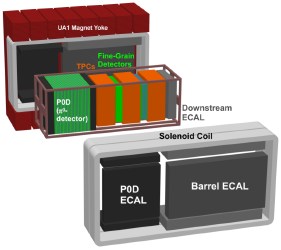
The T2K near detector complex consists of two main parts: the on-axis detector INGRID, which is designed to monitor the beam profile and neutrino interaction rate, and the off-axis ND280, which is intended to characterise the unoscillated beam at the same off-axis angle as Super-K and to measure neutrino interaction cross-sections.
ND280 is built around the former UA1 dipole magnet, which in this configuration produces a field of 0.2 T. It consists of two principal subdetectors:
- the Pi-0 Detector or P0D, a tracking calorimeter consisting of plastic scintillator bars interleaved with metal foil and water bags (the latter intended to provide a water target for direct comparison with Super-K);
- the Tracker, consisting of three time-projection chambers (TPCs) for precision tracking of charged particles, interleaved with two fine-grained detectors (FGDs), constructed of plastic scintillator bars (and water layers in the case of FGD2) and providing an active target for neutrino interactions, and surrounded on five sides by the ECal, a sampling calorimeter of plastic scintillator bars and lead sheets.
In principle, as its name suggests, the P0D is designed for π0 reconstruction while the Tracker is intended to analyse charged-particle final states. However, the combination of charged-particle tracking and electromagnetic calorimetry does provide the necessary functionality for π0 reconstruction, providing a cross-check of the P0D results with different systematic errors.
Charged current π0 (CC1pi0) production
(Matt Lawe, Jon Perkin)
In a CC1pi0 event, the interaction is a W exchange and the neutrino converts to a muon. This interaction is less serious as a background to νe appearance than the neutral current production (see below) because in Super-K the muon would produce a Cherenkov ring and the event would be rejected. However, the two processes are closely related, and the CC events are easier to reconstruct because the muon track defines the event vertex.
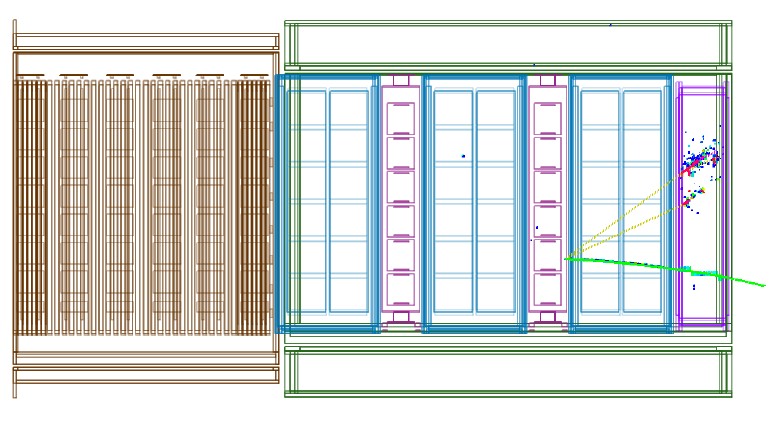
|
| Event display showing a CC1pi0 event with a vertex in FGD2 and all particles – the two photons and the muon – entering the downstream ECal. |
In this analysis, the muon was identified using cuts developed by the νμ working group and the π0 was reconstructed from two isolated ECal showers. The event vertex is required to lie in one of the FGDs, and the ECal showers may be detected in the barrel or downstream ECals. This yields six different event topologies (three ECal combinations, DsDs, DsBrl and BrlBrl, for each FGD) which have different kinematic acceptance and were analysed individually.
After the muon selection, events with two or three isolated ECal clusters were selected as π0 candidates. The principal selection tool was a boosted decision tree (BDT), a form of multivariate analysis. BDTs, neural networks and similar multivariate analyses are valuable because (1) they can take correlations between variables into account and (2) they are optimised by "training" on samples where the desired outcome is known (generally simulations), so that there is no need for the user to know exactly what the discriminating features are.
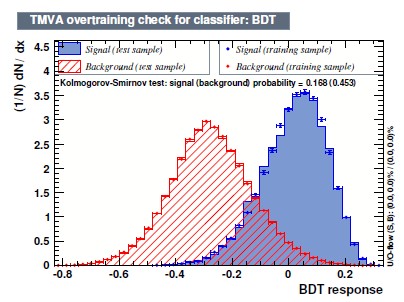
|
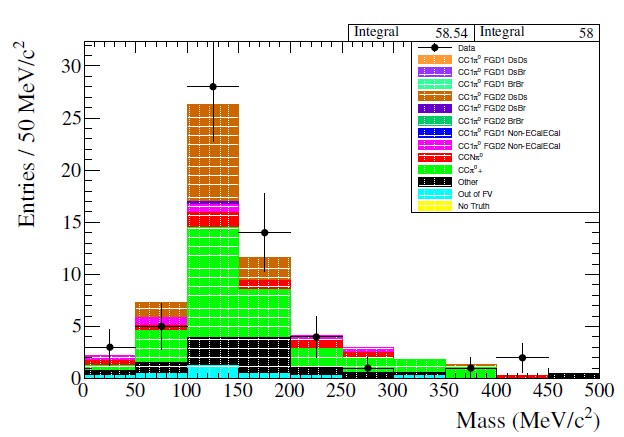
|
| Sample BDT response showing the discrimination between signal and background. | Invariant mass plot for the FGD2-DsDs topology. The points with error bars are the data; the brown histogram is the desired signal, and the main background (green) is CCpi0+, in which a π0 is produced along with other particles. |
This analysis comes from Matt Lawe's PhD thesis.
Neutral current π0 (NC1pi0) production
(Leon Pickard)
The channel most directly relevant to νe appearance background is single π0 production, NC1pi0. This channel is extremely difficult to study because ND280 does not usually reconstruct the recoil proton, and therefore there is no charged track to locate the vertex. In addition, the efficiency for reconstructing the softer photon from the π0 decay is low, so events with two reconstructed ECal showers usually had more than just a single π0 in the true final state.
The original ND280 tracker analysis of this channel was done by Sam Short of Imperial College. This analysis produced a sample of 58 events, with an overall efficiency of 22% and a purity of 16%. The DsDs topology had the highest efficiency and purity, but accounted for only 5 of the 58 events.
The current Sheffield analysis aims to make use of better reconstruction tools and better understanding of the detector to improve on this analysis. The initial stage of this work consisted of porting the analysis to the current ND280 analysis framework. Following this, each cut has been critically analysed to investigate whether it is optimal in the current framework. An example is illustrated in the figure below: if a particle identification cut is imposed only on photon candidates above 200 MeV, the purity is increased by a factor of 3.6, with only an 8% loss in efficiency.
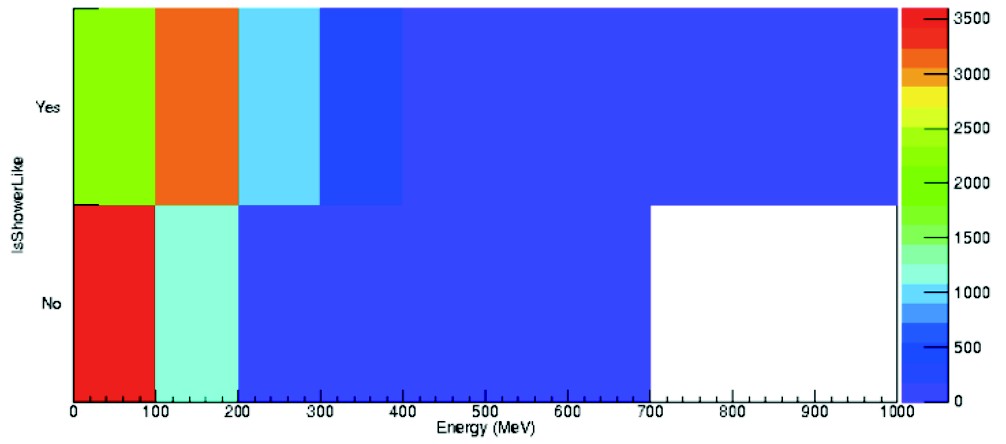
|
| Particle identification for the lower-energy photon from a π0 decay, showing that photons with energies < 100 MeV are generally identified as track-like. Based on this study, it has been decided to require that all candidate photons with energies above 200 MeV be identified as shower-like, but not lower-energy photons. |
Low energy reconstruction in the ECal
(Mike Wallbank)
A major limitation in π0 analyses using ECal showers (as opposed to e+e– conversions reconstructed in the TPCs) is the poor efficiency of the ECal at energies below 100 MeV. As can be seen from the above plot, most of the softer photons from π0 decay fall into this energy range, which means that the efficiency for reconstructing π0s is both small and extremely dependent on the efficiency vs energy curve (and therefore potentially subject to large systematic errors if this is not well reproduced in the MC). In view of this, the T2K-UK group set up a low-energy task force to attempt to improve the ECal reconstruction below 200 MeV.
As part of this task force, Mike Wallbank has investigated all stages of the ECal reconstruction. As expected, the principal cause of lost low-energy showers was a failure to combine the small number of hit bars into a reconstructed cluster. Mike has shown that replacing the standard "basic" clustering algorithm with a "blurred clustering" algorithm, in which each hit is artificially smeared over neighbouring bars to increase the probability of finding additional non-contiguous hits, significantly improves the efficiency at low energies without impairing reconstruction at high energies.
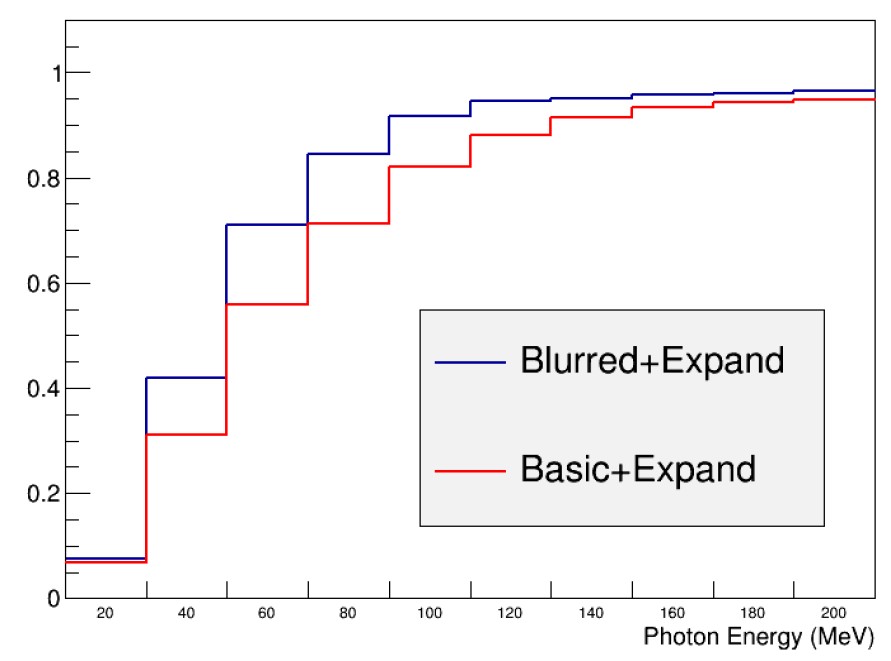
|
| Efficiency of ECal cluster-finding for "basic" and "blurred" algorithms. |

